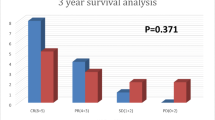Abstract
Squamous cell carcinoma of head and neck region account for more than 25 % of male and more than 10 % of female cancers in India (1). Head and neck cancer treatment includes a multidisciplinary approach involving all specialties. Concurrent chemo-radiation is the standard of care in most of the subsites (2). Inspite of the multi-disciplinary approach, a plateau has been reached in terms of results with 5 year survival of locally advanced disease of around 30 % (3). In order to improve outcomes, there has been considerable interest in molecular profiling of head and neck cancers 4-10. However there is still significant paucity in terms of Indian data, hence the need for the study. The objectives are to assess the HPV-p16, EGFR and p53 status, to correlate HPV-p16, EGFR and p53 status with the response rates, to correlate HPV-p16,EGFR and p53 status with other factors like age, sex, tobacco use. Twenty five consecutive cases of histopathologically proven head and neck cancers were accrued. All patients were treated with external radiation to a dose of 66Gy in 33 fractions along with concurrent weekly cisplatin chemotherapy at a dose of 40mg/sqm. HPV-p16, EGFR and p53 mutation analysis was done on paraffin embedded histopathological blocks. PCR technique used for HPV-p16, EGFR and p53 status detection. Response assessment was done based on RECIST criteria. Correlation of HPV, EGFR and p53 status on response was done. The EGFR positivity rate was 84 %, the p53 positivity rate was 76 % and the HPV p-16 positivity rate was 28 %. Out of 25 patients, 13(52%) had complete response, 7(28 %) had partial response, 3(12 %) had stable disease and 2(8 %) had progressive disease. On correlation of molecular profile with response, there was no statistical significance between EGFR status and response (p 0.5) or HPV-p16 and response (p 0.8). However, p53 positivity was approaching significance with respect to good response (p 0.07).


Similar content being viewed by others
References
Elango JK, Gangadharan P, Sumithra S, Kuriakose MA (2006) Trends of head and neck cancers in urban and rural India. Asian Pac J Cancer 7:108–112
Pignon JP, Maitre A, Maillard E, Bourhis J (2009) Meta analysis of chemotherapy in head and neck cancer (MACH – NC): an update of 93 randomized controlled trials and 17, 346 patients. Radiother Oncol 92:4–14
Lajer CB, Von Buchwald C (2010) The role of human papilloma virus in head and neck cancer. APMIS 118:510–519
Zimmermann M, Zouhair A, Azria D, Ozsahin M (2006) The epidermal growth factor receptor (EGFR) in head and neck cancer: its role and treatment implications. Radiat Oncol 1:11
Suh Y, Amelio I, Guerrero TU, Tavassoli M (2014) Clinical update on cancer: molecular oncology of head and neck cancer. Cell Death and Disease 5:e1018. doi:10.1038/cddis.2013.548
Bova RJ, Quinn DI, Nankervis JS, et al. (1999) Cyclin D1 and p16INK4A expression predict reduced survival in carcinoma of the anterior Tongue. Clin Cancer Res 5:2810–2819
Yuen PW, Man M, Lam KY, Kwong YL (2002) Clinicopathological significance of p16 gene expression in the surgical treatment of head and neck squamous cell carcinomas. J Clin Pathol 55:58–60
Reimers N, Kasper HU, Weissenborn SJ, et al. (2007) Combined analysis of HPV-DNA, p16 and EGFR expression to predict prognosis in oropharyngeal cancer. Int J Cancer 120(8):1731–1738
Ang KK, Berkey BA, Tu X, et al. (2002) Impact of epidermal growth factor receptor expression on survival and pattern of relapse in patients with advanced head and neck carcinoma. Cancer Res 62:7350–7356
Geisler SA, Olshan AF, Weissler MC, et al. (2002) p16 and p53 protein expression as prognostic indicators of survival and disease recurrence from head and neck cancer. Clin Cancer Res 8:3445–3453
Pruneri G, Pignataro L, Carboni N (1998) Clinical relevance of p53 and bcl-2 protein over-expression in laryngeal squamous-cell carcinoma. Int J Cancer 79:263–268
Acknowledgments
Division of Onco-Therapeutics, Clinigene Labs, Biocon House, Bangalore-for their support in conducting EGFR mutation analysis.
Department of Pathology, M.S. Ramaiah Medical College for conducting p53 and HPV p16 mutation analysis.
Author information
Authors and Affiliations
Corresponding author
Ethics declarations
Conflict of Interest
None
Rights and permissions
About this article
Cite this article
Sathyamurthy, A., Koushik, A.S.K., Gowri, M. et al. Impact of Molecular Predictors on the Response Rates in Head and Neck Cancer Patients – an Observational Study. Indian J Surg Oncol 7, 380–385 (2016). https://doi.org/10.1007/s13193-016-0524-2
Received:
Accepted:
Published:
Issue Date:
DOI: https://doi.org/10.1007/s13193-016-0524-2




